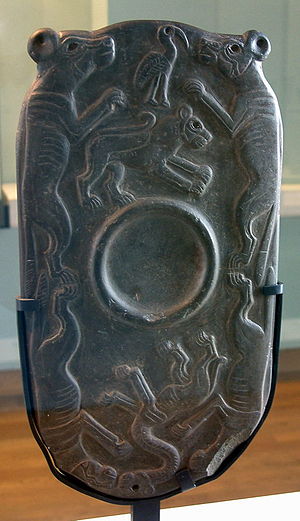- Cosmetic palette
-
 The Four Dogs Palette, Room 20 of the Louvre.
The Four Dogs Palette, Room 20 of the Louvre.
The cosmetic palettes of middle to late predynastic Egypt are archaeological artifacts, originally used to grind and apply ingredients for facial or body cosmetics. The decorative palettes of the late 4th millennium BCE appear to have lost this function and became commemorative, ornamental, and possibly ceremonial. They generally were made of softer and workable stone such as slate or mudstone.
Many of the palettes were found at Hierakonpolis, a centre of power in pre-dynastic Upper Egypt. After the unification of the country, the palettes ceased to be included in tomb assemblages.
Contents
Notable palettes
Notable decorative palettes are:
- The Narmer Palette, thought by some to depict the unification of Upper and Lower Egypt under the pharaoh Narmer, Egyptian Museum, Cairo
- Libyan Palette, Egyptian Museum, Cairo
- The Dogs Palette, displaying canines, giraffes, and other quadrupeds, Louvre
- The Battlefield Palette, British Museum and Ashmolean Museum
- The Bulls Palette, showing a bull, representing the king, goring his enemies
- The Hunters Palette, British Museum and Louvre
Even undecorated palettes were often given pleasing shapes, such as the zoomorphic palettes, which included turtles and, very commonly, fish. The fish zoomorphic palette often had an upper-centrally formed hole, presumably for suspension, and thus display.
The Near East stone palettes are from Canaan,[1] Bactria, and Gandhara.
History of Egyptian palettes
The first stone palettes appear in the predynastic societies of Ancient Egypt. They are the rhomboidal palettes. They did not contain the circular mixing-pool found on later palettes.
List of ancient Egyptian Predynastic palettes
Name Dimensions Location Notes + Topic Battlefield Palette
Vultures Palette, etcFull Height?
50 x 32 cm-(?)
(20 x 13 in)British Museum Side A: war; Side B: peace
('Order vs Chaos')Bull Palette Hunters Palette 30.5 x 15 cm
(12 x 6 in)British Museum Libyan Palette Min Palette Narmer Palette
Great Hierakonpolis Palette64 x 42 cm
(25 x 17 in)Louvre Unification of Southern Egypt, Delta Egypt See also
References
- David Wengrow, The Archaeology of Early Egypt: Social Transformations in North East Africa, Cambridge University Press 2006
- Erik Hornung, Conceptions of God in Ancient Egypt: the one and the many, Cornell University Press 1982
- ^ Festschrift, Rëuben R. Hecht, Korén Publishers 1979
External links
- Corpus of Egyptian Late Predynastic Palettes by Francesco Raffaele
- Cosmetic Palettes, University College London
This African archaeology article is a stub. You can help Wikipedia by expanding it. This article relating to archaeology in the Near East is a stub. You can help Wikipedia by expanding it.
